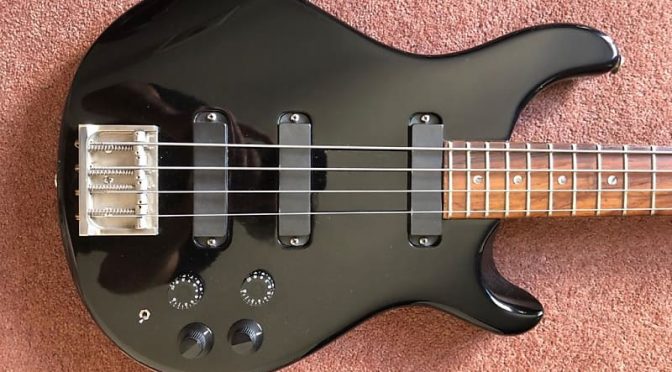PRS Bass 4 – 1986 rare Paul Reed Smith bass guitar – the 29th ever made
I’m not a vintage guitar or bass collector. The oldest instrument I ever owned before this was my first ever bass. My parents bought that one for me in 1994. However, when I saw this 1986 PRS Bass 4 on sale in the UK at a price I could afford, I was intrigued. I’ve played a few PRS guitars in my life. I’ve always been impressed by them. I own an S2 Standard 24 which you can see in the video. It’s a really well made guitar. However, as a bass player I’ve always been curious to know if the legendary Paul Reed Smith had designed and built any basses that were as good as his guitars. It turns out he has!
Paul Reed Smith Bass Guitars
So, I had it in the back of my mind that I wanted to try a PRS bass. But it’s not that easy to try one in the UK at the moment. PRS doesn’t make that many basses. The only bass model being manufactured in the US is the Grainger 4 and 5. They retail for over 3000 Euros in Europe. Getting one would also involve paying import duties in the UK as we are no longer part of the EU. That’s a bigger investment than I can afford.
Alternatively, there are a couple of PRS SE basses called the Kingfisher and the Kestrel. The SE basses retail for under £1000 in the UK. They are made for Paul Reed Smith under license by a company called Cor-Tek in Indonesia. I’ve played PRS SE guitars, and they’re great. But it’s not quite the same thing as playing one of the US made core instruments.
My Paul Reed Smith Bass IV
So, when this bass came up for sale, you can see why it seemed like an opportunity too good to pass up. I’m always slightly nervous about buying second hand. It’s hard to know if the seller has been less than forthcoming about the true condition of the instrument. So, I asked the seller to send me some extra photos. He was very obliging and sent me everything I requested. He told me he had owned the bass since 2002 and hardly played it at all. And that shows in the condition of the bass which is absolutely excellent for an instrument that is nearly 35 years old. It has some scratches and marks on the back, but the front is in excellent condition. It’s nearly the same age as me, but it’s definitely in better condition for it’s age.
Three Pickups on a Bass?
The design of the bass is what I think makes it so special. The pickups and the pickup configuration are excellent. Three single coil pickups, each with a very different tonal flavour. The way the pickups are spaced is very well thought out. The space has been maximised to ensure the maximum tonal variety between the three positions. I’ve played three pickup guitars where the pickups have been right next to each other. In those situations, the middle pickup doesn’t make enough tonal difference to be worth bothering with.
In the case of this bass, the spacing on the pickups ensures a significantly different character to the middle pickup. The neck pickup is a classic neck pickup with a woody jazz tone, the bridge pickup gives you classic mid range punch and the middle pickup give you a very usable classic single coil electric bass tone.
Then add to that two hum-cancelling positions made by combining the bridge pickup with either the middle or neck pickup. Suddenly you have a lot of different and very usable electric bass tones at your disposal, even before you engage the active circuitry. When you play the bass in passive mode, the active treble control seems to act as a very subtle passive tone control. When you engage the active controls, which completely changes the character of the sound, you suddenly realise that this bass is really capable of doing a lot of different things. The video I’ve made really only scratches the surface.
A Compact and Versatile Bass Design
This might be the most versatile bass design I’ve ever played. The compact body size and the two and two headstock make for a small bass with a long scale length which balances beautifully and plays as well as all PRS instruments seem to. I think it’s really a shame that this brilliant piece of design never caught on.
The only reason I can think of for why it didn’t is because after the 1980’s both guitarists and bass players seemed to stop looking for innovation in instrument design. It seems like everybody just wanted to go back to the classic bass designs. If it wasn’t a J or a P or a MusicMan Stingray (all Leo’s most famous designs) then no one seemed to be interested. I think it’s a shame. I have nothing against Leo Fender, but surely there is room for innovative designs in the bass world alongside his classics.
I’m very happy with my purchase. I didn’t buy this bass to hang it on the wall or put in a display case. I’m a player not a collector, I bought this bass to play it, and I will certainly do that. I suspect that this also might get more valuable as time goes by. But if it does, that’s just an added bonus.

